
(a)
When the imported bananas are infected with a deadly virus what happens to the
Explanation of Solution
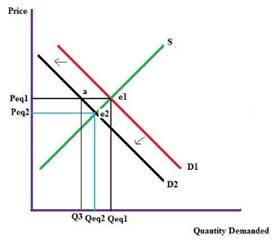
A report says that the bananas that have been imported are infected with a deadly virus, this will lead to the shift of consumers towards other fruits available in the market. Hence, the demand for the bananas will be less which will shift the demand curve towards left.
In the given graph, D1 is the initial demand curve, S is the initial supply curve, Peq1 is the initial
Demand and supply are the basic concepts in economics, and they can vary depending on various factors. Demand can be defined as how much quantity of the product or service is demanded or can be availed by a customer.
Whereas Supply how much quantity of products or services is available in the market.
(b)
When the consumers' income drops or decreases what happens to the demand and supply curve.
Explanation of Solution
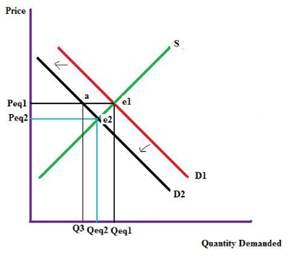
A fall in consumer income will reduce the demand as his disposable income, so demand curve shifts down, which in turn reduces the price of the product. In the given graph, D1 is the initial demand curve S is the initial supply curve, Peq1 is the initial price and Qeq1 is the initial quantity. Due to change in income demand curve shifts to the left to D2. Price Peq1 is same but demand come down i.e. Q3 which lower than Qeq1 creating a surplus in the market. This in turn shifts the price to a new equilibrium point e2 and price changes to Peq2.and quantity become Qeq2.
Demand and supply are the basic concepts in economics, and they can vary depending on various factors. Demand can be defined as how much quantity of the product or service is demanded or can be availed by a customer.
Whereas Supply how much quantity of products or services is available in the market.
(c)
When the price of banana rises what happens to the demand and supply curve.
Explanation of Solution
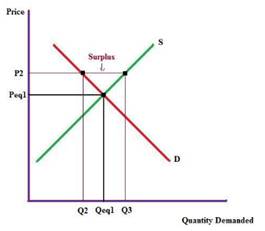
Demand is function of price and the quantity demanded. Hence, demand curve shifts when there is variation in the price and quantity demanded of the product. When price of banana rises quantity demanded will fall, which will create a surplus in the market.
Demand and supply are the basic concepts in economics, and they can vary depending on various factors. Demand can be defined as how much quantity of the product or service is demanded or can be availed by a customer.
Whereas Supply how much quantity of products or services is available in the market.
(d)
When the price of oranges falls what happens to the demand and supply curve.
Explanation of Solution
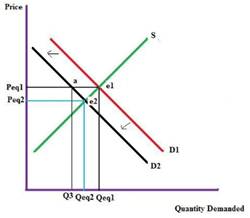
Oranges are a substitute to bananas. As the price of oranges fall, it causes a shift in the consumers preference. They start consuming more oranges than bananas. So, the quantity demanded for bananas fall and the demand curve of bananas shifts toward left reducing the price and consumption. Hence, at the new equilibrium point e2 price is reduced to Peq2 and quantity id reduced to Qeq2.
Demand and supply are the basic concepts in economics, and they can vary depending on various factors. Demand can be defined as how much quantity of the product or service is demanded or can be availed by a customer.
Whereas Supply how much quantity of products or services is available in the market.
(e)
When the consumers assume the price of bananas to fall in future what happens to the demand and supply curve.
Explanation of Solution
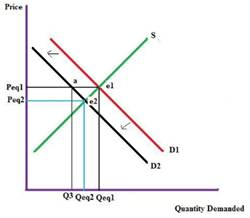
When consumers feel the price of bananas would fall in future, they would stop the consumption of bananas at the current price creating a surplus in the market. This would lead to reduction in price of the bananas. At the new point of
Demand and supply are the basic concepts in economics, and they can vary depending on various factors. Demand can be defined as how much quantity of the product or service is demanded or can be availed by a customer.
Whereas Supply how much quantity of products or services is available in the market.
Want to see more full solutions like this?
- A decrease in money demand causes the real interest rate to _____ and output to _____ in the short run, before prices adjust to restore equilibrium. Group of answer choices rise; rise fall; fall fall; rise rise; fallarrow_forwardIf a country's policy makers were to continously use expansionary monetary policy in an attempt to hold unemployment below the natural rate , the long urn result would be? Group of answer choices a decrease in the unemployment rate an increase in the level of output All of these an increase in the rate of inflationarrow_forwardA shift in the Aggregate Supply curve to the right will result in a move to a point that is southwest of where the economy is currently at. Group of answer choices True Falsearrow_forward
- An oil shock can cause stagflation, a period of higher inflation and higher unemployment. When this happens, the economy moves to a point to the northeast of where it currently is. After the economy has moved to the northeast, the Federal Reserve can reduce that inflation without having to worry about causing more unemployment. Group of answer choices True Falsearrow_forwardThe long-run Phillips Curve is vertical which indicates Group of answer choices that in the long-run, there is no tradeoff between inflation and unemployment. that in the long-run, there is no tradeoff between inflation and the price level. None of these that in the long-run, the economy returns to a 4 percent level of inflation.arrow_forwardSuppose the exchange rate between the British pound and the U.S. dollar is £1 = $2.00. The U.S. government implementsU.S. government implements a contractionary fiscal policya contractionary fiscal policy. Illustrate the impact of this change in the market for pounds. 1.) Using the line drawing tool, draw and label a new demand line. 2.) Using the line drawing tool, draw and label a new supply line. Note: Carefully follow the instructions above and only draw the required objects.arrow_forward
- Just Part D please, this is for environmental economicsarrow_forward3. Consider a single firm that manufactures chemicals and generates pollution through its emissions E. Researchers have estimated the MDF and MAC curves for the emissions to be the following: MDF = 4E and MAC = 125 – E Policymakers have decided to implement an emissions tax to control pollution. They are aware that a constant per-unit tax of $100 is an efficient policy. Yet they are also aware that this policy is not politically feasible because of the large tax burden it places on the firm. As a result, policymakers propose a two- part tax: a per unit tax of $75 for the first 15 units of emissions an increase in the per unit tax to $100 for all further units of emissions With an emissions tax, what is the general condition that determines how much pollution the regulated party will emit? What is the efficient level of emissions given the above MDF and MAC curves? What are the firm's total tax payments under the constant $100 per-unit tax? What is the firm's total cost of compliance…arrow_forward2. Answer the following questions as they relate to a fishery: Why is the maximum sustainable yield not necessarily the optimal sustainable yield? Does the same intuition apply to Nathaniel's decision of when to cut his trees? What condition will hold at the equilibrium level of fishing in an open-access fishery? Use a graph to explain your answer, and show the level of fishing effort. Would this same condition hold if there was only one boat in the fishery? If not, what condition will hold, and why is it different? Use the same graph to show the single boat's level of effort. Suppose you are given authority to solve the open-access problem in the fishery. What is the key problem that you must address with your policy?arrow_forward
- 1. Repeated rounds of negotiation exacerbate the incentive to free-ride that exists for nations considering the ratification of international environmental agreements.arrow_forwardFor environmental Economics, A-C Pleasearrow_forwardTrue/ False/ Undetermined - Environmental Economics 3. When the MAC is known but there is uncertainty about the MDF, an emissions quota leads to a lower deadweight loss associated with this uncertainty.arrow_forward
 Economics (MindTap Course List)EconomicsISBN:9781337617383Author:Roger A. ArnoldPublisher:Cengage Learning
Economics (MindTap Course List)EconomicsISBN:9781337617383Author:Roger A. ArnoldPublisher:Cengage Learning

 Microeconomics: Private and Public Choice (MindTa...EconomicsISBN:9781305506893Author:James D. Gwartney, Richard L. Stroup, Russell S. Sobel, David A. MacphersonPublisher:Cengage Learning
Microeconomics: Private and Public Choice (MindTa...EconomicsISBN:9781305506893Author:James D. Gwartney, Richard L. Stroup, Russell S. Sobel, David A. MacphersonPublisher:Cengage Learning Macroeconomics: Private and Public Choice (MindTa...EconomicsISBN:9781305506756Author:James D. Gwartney, Richard L. Stroup, Russell S. Sobel, David A. MacphersonPublisher:Cengage Learning
Macroeconomics: Private and Public Choice (MindTa...EconomicsISBN:9781305506756Author:James D. Gwartney, Richard L. Stroup, Russell S. Sobel, David A. MacphersonPublisher:Cengage Learning Economics: Private and Public Choice (MindTap Cou...EconomicsISBN:9781305506725Author:James D. Gwartney, Richard L. Stroup, Russell S. Sobel, David A. MacphersonPublisher:Cengage Learning
Economics: Private and Public Choice (MindTap Cou...EconomicsISBN:9781305506725Author:James D. Gwartney, Richard L. Stroup, Russell S. Sobel, David A. MacphersonPublisher:Cengage Learning





